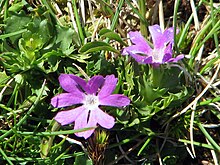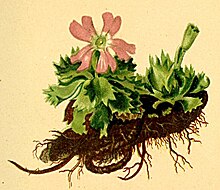Dwarf primrose
| Dwarf primrose | ||||||||||||
|---|---|---|---|---|---|---|---|---|---|---|---|---|

Dwarf primrose ( Primula minima ) |
||||||||||||
| Systematics | ||||||||||||
|
||||||||||||
| Scientific name | ||||||||||||
| Primula minima | ||||||||||||
| L. |
The dwarf primrose ( Primula minima ) belongs to the genus of primroses ( Primula ). The mountain farmers in the Giant Mountains also called them "Habmichlieb" / "Habmichlieb".
description

Vegetative characteristics
The dwarf primrose is a grassy, perennial herbaceous plant and, with a growth height of up to 4 centimeters, the smallest Central European primrose species. It appears to be bald, but almost everywhere is covered with glandular hairs about 0.03 to 0.05 millimeters long.
The glossy leaves are arranged in small, crowded rosettes. The leaf blades are wedge-shaped with a length of about 15 millimeters with a truncated upper end. The leaf margin has full margins on the sides and has three to nine coarse saw teeth narrowed into a cartilage point at the upper end.
Generative characteristics
The flowering period extends from June to July. The flowers are usually individually on a 2 to 8 millimeter long peduncle over one to two lanceolate bracts .
The hermaphroditic flowers are radial symmetry and five-fold with a double flower envelope . The approximately 5 to 8 millimeters long calyx has five egg-shaped calyx teeth. The bright red crown is 15 to 30 millimeters in diameter, disproportionately large for the small leaf rosettes. The crown has a white, glandular throat and wedge-shaped, deeply incised corolla lobes.
The chromosome number is 2n = 66, (64, 67, 68, 69, 70, 73).
Hybrids
The dwarf primrose occasionally forms hybrids with the genetically closely related Clusius primrose ( Primula clusiana ), which occurs in about the same range in the Alps.
Occurrence
The dwarf primrose is native to the mountains of Central and Eastern Europe. In the Alps it occurs from the Brenner Pass eastwards to the Wiener Schneeberg , from Bavaria to the Tonale Pass at altitudes of 1700 to 3000 meters. Further occurrences are the Giant Mountains (from 1200 meters), the Tatra Mountains , the Carpathians , Albanian Alps, the High Balkans and the Rhodope Mountains in Bulgaria. The dwarf primrose is a typical Eastern Alpine plant .
In Austria it occurs moderately often in the (sub) alpine altitude range and is absent in Vienna, Burgenland and Vorarlberg.
The dwarf primrose thrives best on acidic, lime-poor or lime-free, humus-musty and stony-loamy soils . It grows on fresh (silicate) grasslands (Krummseggenrasen) and snow soils. It colonizes snow valleys and dormant rubble, but it also goes on wind-swept lawns close to burrs and in fine rock crevices. It is a character species of the Primulae-Caricetum curvulae from the class of the crooked sedge (Juncetea trifidi), but also occurs in the Caricetum firmae, in the Elynetum or in Nardion societies.
Others
- The dwarf primrose was first described and illustrated by Clusius in his famous book Rariorum plantarum historia (1601) on page 305 as Auricula ursi VIII minima .
- Alpine plants that live under such extreme environmental conditions (temperature, weather, ...) as the dwarf primrose often use cloning for reproduction. Reisch and Kellermeier investigated whether the dwarf primrose reproduces primarily through cloning or through sexual reproduction. Their genetic studies surprisingly show that the dwarf primrose is primarily sexually reproduced.
- The dwarf primrose is, among other things, the heraldic plant of the Giant Mountains Association .
- Hoffmann von Fallersleben [1] wrote the poem "Das Koppenblümchen Habmichlieb" around 1848 in honor of the dwarf primrose:
Let's get on our heads,
now spring has awakened!
I
want to show you a little flower there
that laughs happily at you,
What my heart never dared,
the dear little flower tells you.
"Love me!"
How it sprouts on bare rock
between moss and grass,
and
opens its pink goblet in the warm sunshine !
I love me, that's what it says to you,
darling, come and pick it for me.
"Love me!"
Flowers bloom in every place,
flowers bloom on mountains and valleys,
but only
one person has words, one greets you a thousand times.
What my heart never dared,
the dear little flower tells you.
"Love me!"
literature
- Xaver Finkenzeller, Jürke Grau: Alpine flowers. Recognize and determine (= Steinbach's natural guide ). Mosaik, Munich 2002, ISBN 3-576-11482-3 .
- Wolfgang Adler, Karl Oswald, Raimund Fischer: Excursion flora of Austria . Ed .: Manfred A. Fischer. Eugen Ulmer, Stuttgart / Vienna 1994, ISBN 3-8001-3461-6 .
- Dietmar Aichele, Heinz-Werner Schwegler: The flowering plants of Central Europe . 2nd Edition. tape 3 : Evening primrose plants to reddish plants . Franckh-Kosmos, Stuttgart 2000, ISBN 3-440-08048-X .
- Gustav Hegi : Illustrated Flora of Central Europe , Volume V Part 3, Second Edition, Carl Hanser Verlag, Munich 1966.
- Thomas Gaskell Tutin et al. a. (Ed.): Flora Europaea: Diapensiaceae to Myoporaceae, Vol. 3 , Cambridge University Press, Cambridge (UK) 1973, ISBN 052108489X .
- Li-Bing Zhang, Joachim W. Kadereit: Classification of Primula sect. Auricula (Primulaceae) based on two molecular data sets (ITS, AFLPs), morphology and geographical distribution. In: Botanical Journal of the Linnean Society , Volume 146, 2004, pp. 1-26.
Individual evidence
- ^ Li-Bing Zhang, Joachim W. Kadereit: Classification of Primula sect. Auricula (Primulaceae) based on two molecular data sets (ITS, AFLPs), morphology and geographical distribution. In: Botanical Journal of the Linnean Society , Volume 146, 2004, pp. 1-26.
- ↑ Hegi, pp. 1782-1784
- ^ Erich Oberdorfer : Plant-sociological excursion flora for Germany and neighboring areas . With the collaboration of Angelika Schwabe and Theo Müller. 8th, heavily revised and expanded edition. Eugen Ulmer, Stuttgart (Hohenheim) 2001, ISBN 3-8001-3131-5 , pp. 738 .
- ↑ Christoph Reisch and Jasmin Kellermeier: Microscale variation in alpine grasslands: AFLPs reveal a high level of genotypic diversity in Primula minima . In Botanical Journal of the Linnean Society , Vol. 155, 2007, pp. 549-556.
Web links
- Primula minima L., dwarf primrose. In: FloraWeb.de.
- Dwarf primrose . In: BiolFlor, the database of biological-ecological characteristics of the flora of Germany.
- Thomas Meyer: Primrose data sheet with identification key and photos at Flora-de: Flora von Deutschland (old name of the website: Flowers in Swabia )
- Clusius: Rariorum plantarum historia (1601) .
- Illustration of the dwarf primrose at Clusius


